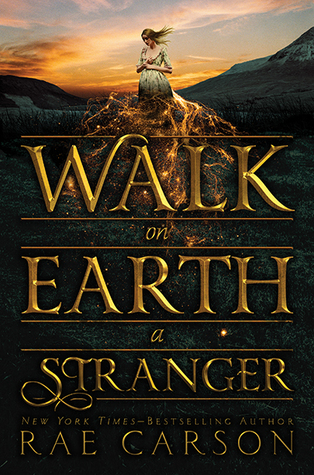It’s no secret that I loved Rae Carson’s GIRL OF FIRE AND THORNS trilogy, so when I heard she was beginning a new fantasy trilogy — a historical fantasy, set during the California gold rush — my fingers immediately began itching for a copy. Fortunately, I had a friend who generously offered to loan me her ARC (once she was finished reading, of course — there is generous, and then there’s just plain ridiculous), so I was able to read WALK ON EARTH A STRANGER a few months early.
And guys, I didn’t even think it was possible, but if the first book is anything to go by, I think the Gold Seer Trilogy may be even better than GIRL OF FIRE AND THORNS.
I know. Take a moment.
The Plot (from Goodreads):
Lee Westfall has a secret. She can sense the presence of gold in the world around her. Veins deep beneath the earth, pebbles in the river, nuggets dug up from the forest floor. The buzz of gold means warmth and life and home—until everything is ripped away by a man who wants to control her. Left with nothing, Lee disguises herself as a boy and takes to the trail across the country. Gold was discovered in California, and where else could such a magical girl find herself, find safety?
Walk on Earth a Stranger, the first book in this new trilogy, introduces—as only Rae Carson can—a strong heroine, a perilous road, a fantastical twist, and a slow-burning romance. Includes a map and author’s note on historical research.
My Thoughts:
Before I dig into my thoughts on the first book in Rae Carson’s new Gold Seer Trilogy, let’s discuss genre for a minute. While WALK ON EARTH A STRANGER is being marketed as a fantasy, and while the opening chapter firmly establishes Leah Westfall’s ability to magically sense the presence of gold, once you move past the events that set Leah off on her cross-country journey, I was surprised to find that the majority of the book reads like a straight historical. Who knows, maybe future installments in the series will play up the magic more, but going off of just this first book, it feels a bit more accurate to call WOEAS historical fiction with some magical realism elements, rather than a fantasy
That said, even though I’d been prepared for a fantasy, I was not disappointed in the slightest to find magic missing from the majority of WOEAS. Leah — who starts going by “Lee” early in the book, when she disguises herself as a boy — is an utterly compelling narrator, and Carson’s prose is simultaneously lush and gritty, masterfully evoking the visuals and sounds and smells of a late-1800s America. The staggering amount of research that must have gone into this novel is evident on every page, immersing the reader in the endlessly beautiful — yet unforgivingly harsh — American frontier.
Though the ensemble cast seems kind of sprawling at first, Carson skillfully manages to develop her characters into fully three-dimensional people after surprisingly little page time. It didn’t take long before I was rooting not just for Leah, but for the families and individuals traveling alongside her. I won’t name names, because some characters have pretty impressive arcs (and some, um, die), but suffice it to say, Leah isn’t the only one who ends the book loving these people like family.
For those of us who grew up playing the video game Oregon Trail, Leah’s journey will come with a distinct sense of nostalgia. While (spoiler alert) Leah never hunkers down for days on end to shoot squirrels, she, along with her fellow travelers, must ford rivers, maneuver covered wagons, manage sick oxen, and battle disease (although not quite as much dysentery as I remember from my Oregon Trail days). Though the wagon train’s trek to California moves agonizingly slowly, the plot never does. Carson is a master of infusing her story with moment-to-moment tension, and even when the characters were sitting still, I found myself flying through the pages.
As with Carson’s first series, [what I suspect will be] the main romantic subplot doesn’t get much exploration in this first book. While there are hints, this is a story of survival and endurance, not romance. However, as a fan of the slow burn, I thoroughly enjoyed the foundations that were so thoughtfully laid in this book, and I think that even readers who prefer a lot of swoon in their fiction will find that, while sparse, there are enough tidbits in this book to carry them through to the next one.
Overall, I found WALK ON EARTH A STRANGER to be a beautiful, vivid, and compulsively readable portrayal of life in Gold Rush-era America, with just a dash of magic. I unequivocally loved it. Whether you are a lover of fantasy or historicals or simply a good story well told, I think you’ll love it, too.

